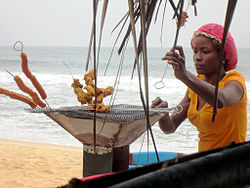Liberian cuisine
| Part of a series on the |
| Culture of Liberia |
|---|
 |
| People |
| Languages |
| Cuisine |
| Festivals |
| Religion |
| Art |
| Music |
| Sport |


Liberian cuisine refers to the cuisine of Liberia. It is centered on unique dishes of rice, cassava, plantain, yam, tropical fruits and vegetables (potatoes, greens, cassava leaf, okra, cabbage), as well as fish, meat and more. Liberian cuisine is also influenced by African American through Americo Liberians and Caribbean food and recipes.
Liberia also has a tradition of baking, including cornbread, sour bread, rice bread, banana bread, and cakes.
Dietary staples
[edit]Starches
[edit]Rice is a staple of the Liberia diet, whether commercial or country ("swamp rice"), and either served "dry" (without a sauce), with stew or soup poured over it, cooked into the classic jollof rice, or ground into a flour to make country breh (bread).[1] The cassava or tapioca root is processed and pounded into starchy foods such as fufu (using dried cassava) and dumboy (using boiled cassava). One especially popular pounded cassava dish is the northeastern regional variant glea-gbar, affectionately known as GB or geebee and generally served with a spicy mixed-meat soup.[1] Eddoes (taro roots) are also eaten.[2]
Fruits and vegetables
[edit]Popular Liberian ingredients include cassava, bananas, citrus fruit, sweet or regular plantains, coconut, okra and sweet potatoes.[3] Heavy stews spiced with habanero and Scotch bonnet chillies are popular and eaten with fufu.[4] Potato greens, the leafy plant of the sweet potato, are widely grown and consumed, as is bitterball (a small vegetable similar to eggplant), and okra.[5]
Other popular stews, referred to as "soups", are toborghee, bitterleaf, cassava leaf and palaver sauce. Toborghee consists of African eggplants which are stewed and spiced with fermented palm oil. It is often bitter in taste and typically associated with the Lorma people inhabiting the area of Lofa.[6][7]
Bitterleaf, referred to as "bittas" by the Sierra Leoneans, consists of bitter leaves mixed with ground melon seeds.[7]
Cassava leaf, referred to as "gbassajama", is made from ground cassava leaves. The leaves are then braised and tenderized in a broth and mixed together with red palm oil stock.[7]
Palaver sauce consists of jute leaves, also referred to as "plateau", that are stewed in a broth.[7]
Fish and meat
[edit]Fish is one of the key animal protein sources in Liberia, with a 1997 study noting that in the Upper Guinea countries (of which Liberia is one), fish made up 30–80% of animal proteins in the diet.[8] However, studies have noted that in that region, consumption of fish actually declined from the 1970s to the 1990s due to "land and catchments degradation".[9][10] Small dried fishes are known as bodies or bonnies.[11][self-published source]
Bushmeat
[edit]Bushmeat is widely eaten in Liberia, and is considered a delicacy.[12] A 2004 public opinion survey found that bushmeat ranked second behind fish amongst Monrovians as a preferred source of protein.[12] Of households where bushmeat was served, 80% of residents said they cooked it "once in a while", while 13% cooked it once a week and 7% cooked bushmeat daily.[12] The survey was conducted during the last civil war, and bushmeat consumption is now believed to be far higher.[12]
Endangered species are hunted for human consumption in Liberia.[13] Species hunted for food in Liberia include elephants, pygmy hippopotamus, chimpanzees, leopards, duikers, and various types of monkeys.[13]
Alcohol
[edit]While Liberia produces, imports, and consumes some standard beers and liquors, the traditional palm wine made from fermenting palm tree sap is popular. Palm wine can be drunk as is, used as a yeast substitute in bread, or used as vinegar after it has soured.[14] A local rum is also made from sugarcane, and called "cane juice"[15] or gana gana.[16]
References
[edit]- ^ a b John Mark Sheppard (3 January 2013). Cracking the Code: The Confused Traveler's Guide to Liberian English. eBookIt.com. pp. 31–. ISBN 978-1-4566-1203-0.
- ^ Patricia Levy; Michael Spilling (1 September 2008). Liberia. Marshall Cavendish. pp. 123–. ISBN 978-0-7614-3414-6.
- ^ "Celtnet Liberian Recipes and Cookery". Celtnet Recipes. Archived from the original on September 3, 2011. Retrieved July 23, 2011.
- ^ "Liberia". Food in Every Country. Retrieved August 27, 2013.
- ^ FAO Plant Protection Bulletin. Food and Agriculture Organization of the United Nations. 1988.
Les plantes fortement attaquees sont le gombo, I'aubergine, le «bitter ball», le niebe et le piment,
- ^ "Most Popular Liberian Food". www.tasteatlas.com. Retrieved 2022-01-26.
- ^ a b c d "Signature Dishes|LIB Food". www.libfood.com. Retrieved 2022-01-26.
- ^ Sue Mainka; Mandar Trivedi (2002). Links Between Biodiversity Conservation, Livelihoods and Food Security: The Sustainable Use of Wild Species for Meat. IUCN. pp. 47–. ISBN 978-2-8317-0638-2.
- ^ Kevin Hillstrom; Laurie Collier Hillstrom (1 January 2003). Africa and the Middle East: A Continental Overview of Environmental Issues. ABC-CLIO. pp. 162–. ISBN 978-1-57607-692-7.
- ^ Modadugu V. Gupta; Devin M. Bartley; Belen O. Acosta (2004). Use of Genetically Improved and Alien Species for Aquaculture and Conservation of Aquatic Biodiversity in Africa. WorldFish. pp. 6–. ISBN 978-983-2346-27-2.
- ^ Quipu Mai Yuan (22 July 2010). The Childhood River. Xlibris Corporation. pp. 99–. ISBN 978-1-4535-4047-3.
- ^ a b c d "FPA - PUL, SWAL Open Book of Condolence for Numennie Williams". www.frontpageafricaonline.com. Archived from the original on 3 March 2016. Retrieved 19 October 2017.
- ^ a b "Poaching in Liberia's Forests Threatens Rare Animals", Anne Look, Voice of America News, May 08, 2012.
- ^ Henk Dop; Phillip Robinson (4 October 2012). Travel Sketches from Liberia: Johann Büttikofer's 19th Century Rainforest Explorations in West Africa. BRILL. pp. 511–. ISBN 978-90-04-23347-8.
- ^ Mary H. Moran (1 March 2013). Liberia: The Violence of Democracy. University of Pennsylvania Press. pp. 125–. ISBN 978-0-8122-0284-7.
- ^ "The Rum Shop at the End of the Universe - Roads & Kingdoms". Retrieved 19 October 2017.
